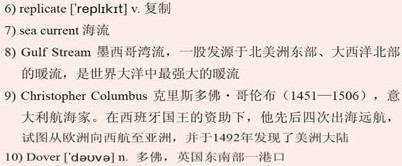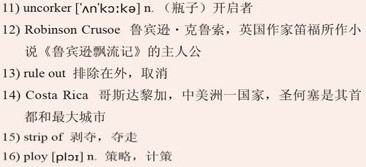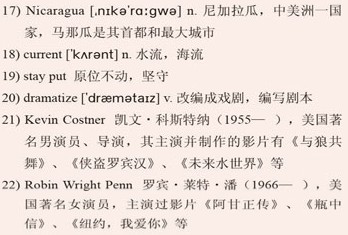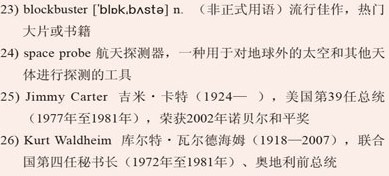What can be more 1)intriguing than a message in a bottle? If you put a message in a bottle, and tossed it into the ocean, what are the 2)odds that someone will find it? Where will it end up, and how long will it take? And who in the world first came up with the concept of a message in a bottle? These are the questions that came to mind when I recently read about Merle Brandell, an Alaskan 3)beachcomber who found a bottle that had been launched by a fourth grade student, Emily Hwaung, in 1986. The bottle took approximately 21 years to travel 1,735 miles from Seattle to Alaska. I decided to do a bit of research on messages in bottles to 4)quench my curiosity. Here’s what I found. 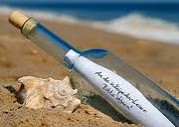 还有什么比一封瓶中信更能引起人们的兴趣呢?如果你把信息放进瓶中,然后投入大海,瓶子被人发现的几率有多大?它将在何地结束漂泊,而在此前它又将要漂泊多久?谁是这世上最先想到瓶中信这个点子的?这些都是最近我看到一条新闻时脑中涌现的问题,据报道,阿拉斯加人默尔·布兰德尔在流连海滩时捡到了一个由四年级学生艾米丽·黄在1986年投出的瓶子。那个瓶子花了近21年的时间从西雅图漂行了1735英里(约2792公里)后到达阿拉斯加。我决定就瓶中信做些许调查,以满足我的好奇心。以下就是我的发现。
还有什么比一封瓶中信更能引起人们的兴趣呢?如果你把信息放进瓶中,然后投入大海,瓶子被人发现的几率有多大?它将在何地结束漂泊,而在此前它又将要漂泊多久?谁是这世上最先想到瓶中信这个点子的?这些都是最近我看到一条新闻时脑中涌现的问题,据报道,阿拉斯加人默尔·布兰德尔在流连海滩时捡到了一个由四年级学生艾米丽·黄在1986年投出的瓶子。那个瓶子花了近21年的时间从西雅图漂行了1735英里(约2792公里)后到达阿拉斯加。我决定就瓶中信做些许调查,以满足我的好奇心。以下就是我的发现。
Although no one knows for sure when the first message in a bottle was released, the ancient Greek philosopher 5)Theophrastus is the first known person to release a message in a bottle. Theophrastus launched his messages in bottles around 310 BC, to himself, in order to prove that the Atlantic flowed into the Mediterranean Sea. The success of his experiment was quite likely the inspiration for Benjamin Franklin to6)replicate it and create his charts of 7)sea currents (in particular the 8)Gulf Stream) in the mid-1700s.
虽然没有人确切地知道第一封瓶中信是在何时投出的,但人们一般认为古希腊哲学家泰奥弗拉斯托斯是第一个投出瓶中信的人。泰奥弗拉斯托斯大约是在公元前310年向自己投出了多封瓶中信,目的在于证明大西洋的海水会流入地中海。他的试验取得了成功,这很可能是激发本杰明·富兰克林的灵感所在——复制其做法,于18世纪中叶绘制出他那幅海流图(特别是墨西哥湾流那部分)。
In the days of early explorers, traveling by ship—and shipwrecks—were common. Once, when 9)Christopher Columbus was caught up in a severe storm, he wrote a report of his discoveries, along with a note asking that his report be passed on to the Queen of Spain. His hope was that his report would be received, even if he did not survive the storm. Columbus survived, but to this day, no one knows what came of his message in a bottle.
在早期的探险家们所处的那个年代,乘船出行以及船只失事是常事。有一次,当克里斯多佛·哥伦布遭遇猛烈风暴时,他就其发现写了一份报告,里面还附了一条信息,请求将他的报告递交给西班牙女王。他希望有人能收到他的报告,即使他没能在那场风暴中幸免于难。结果,哥伦布活了下来,但直到今天,都没有人知道他那封瓶中信的下落。
Although we think of discovering a message in a bottle as an exciting experience, in the 16th century, discovering a message in a bottle and opening it could result in the death penalty. The English Navy used messages in bottles to send information about enemy positions and other intelligence reports. After finding out that a boatman at 10)Dover had opened a bottle containing an intelligence report, Queen Elizabeth I created a new job position: “11)Uncorker of Ocean Bottles.” The Uncorker of Ocean Bottles was the only one permitted to open found bottles. All others who found—and opened bottles—would be put to death.
尽管我们会觉得发现瓶中信是一种令人兴奋的经历,然而在16世纪,人们则可能会因发现并打开瓶中信而被判以死刑。英国海军曾经用瓶中信来传递关于敌军位置及其他情报信息。当发现多佛的一名船夫打开了一个装有情报的瓶子后,伊丽莎白女王一世设立了一种新的工作岗位——“漂流瓶开启者”。漂流瓶开启者是唯一获准打开漂流瓶的人。其他发现并打开瓶中信的人将会被处死。
Most people who consider the actual message in a bottle will picture a 12)Robinson-Crusoe type figure, shipwrecked on a remote island and sending messages for help. Putting a message in a bottle is a most unreliable way to summon help, but shouldn’t be 13)ruled out altogether. In 2005, a group of 88 migrants, consisting mostly of teenagers, were abandoned by people-smugglers off the coast of 14)Costa Rica. When they were abandoned and their vessel 15)stripped of radio and communication equipment, they resorted to the age-old message-in-a-bottle 16)ploy. Their ingenuity paid off when their bottle was found by local fishermen and passed to the only inhabitants of a small island that is a World Heritage Site. The marine protection group who read the message, which simply said “Please help us”, immediately alerted their headquarters. And they were rescued finally. Most other shipwrecked people who resort to sending messages in bottles do not have such a fortunate ending. For example, in 1748, Japanese seaman, Chunosuke Matsuyama who was shipwrecked along with 44 shipmates carved a message on a piece of wood and placed it in a bottle. It was not found until 150 years later. They obviously all starved to death long before the message in the bottle was ever found.
大多数细看瓶中真实信息的人都会构想出一个鲁宾逊·克鲁索这类的人 物——遭遇海难,被困遥远孤岛,正发出信息求救。将信息放进瓶中是最不可靠的求助方式之一,但又不该完全排除其可能性。在2005年,有88个偷渡客,其中大部分是十几岁的青少年,被人贩子抛弃在哥斯达黎加海岸外。船只上的无线电通讯设备已被拆除,他们采取了投出瓶中信这一古老的策略。他们的机智灵招奏效了;瓶子被当地渔民发现,之后交给了驻扎在那个世界遗址小岛上仅有的居民——海上保卫队。海上保卫队读到那条只是简单写着“请帮帮我们”的信息后,立刻向其指挥部报警。最终,他们获救了。其他大多数遇上海难时采取投出瓶中信这一做法的人并没这么走运。例如,1748年,日本水手松山俊辅和44名同船船员遭遇海难后,他在一块木头上刻了一条信息,并将木头放入一个瓶中。直到150年后,这个瓶子才被人发现。显然,在那封瓶中信被人发现以前,他们早就全都饿死了。
If you ever find yourself lost at sea, it won’t hurt to put a message in a bottle and pray for the best. Unfortunately, the odds of a message in a bottle leading to your rescue are slim. It is impossible to predict where a message in a bottle will end up or how long it will take to get there. For example, two bottles were dropped at the same time in the same place of the coast of Brazil. One bottle made its way east and after 130 days was found on a beach in Africa. The other bottle took 190 days to arrive in 17)Nicaragua. The speed which a bottle travels is dependent on wind and 18)current. A bottle may almost 19)stay put for a long period of time, but it is possible for a bottle to travel as much as 100 miles in one day.
如果你在某个时候发现自己在海上迷失了方向,不妨把一条信息放进瓶中,并祈祷最好的情况发生。不幸的是,一封瓶中信使你获救的几率微乎其微。我们根本不可能预知一封瓶中信将在何地结束漂泊,或者要过多久才会到达那儿。例如,在巴西海岸以外的同一个地点同时把两个瓶子投进海里。一个瓶子向东漂流了130天后在非洲的一个沙滩上被发现。另一个瓶子则漂了190天后到达尼加拉瓜。瓶子的漂流速度取决于风力和水流,它可能会长时间几乎一动也不动,也可能会在一天内漂流了100英里(约161公里)。
Today, the term “message in a bottle” has been used by many businesses to describe their service of message delivery, from the straightforward romantic message card to the message drifting through cyberspace. For the romantics among us, the novel Message in a Bottle by Nicholas Sparks was 20)dramatized in a movie starring 21)Kevin Costner and 22)Robin Wright Penn in 1999. Not a 23)blockbuster, perhaps, but worth a watch on a rainy Saturday evening.
今天,“瓶中信”这一短语已被许多商业人士用来描述他们传递信息的服务,从坦率浪漫的留言卡到电脑网络空间里漂流的各种信息。对于我们当中的那些浪漫主义者来说,那部于1999年上映,由尼古拉斯·斯帕克斯创作的小说《瓶中信》(编者注:CR2010年2月号“地道英文”刊登过该小说的节选)改编而成,凯文·科斯特纳和罗宾·莱特·潘主演的电影,或许并不是什么热门大片,但却值得在一个下着雨的周六夜晚看一看。
By far the most travelled “messages in bottles”, however, have to be the Voyager 1 and 2 24)space probes. These probes, launched in the 1970s, are now the furthest man-made objects from Earth. Each has an attached golden disc, containing information from Earth, including ambient sounds and images and greetings from the then-American President 25)Jimmy Carter and the UN Secretary-General26)Kurt Waldheim. The probes will perhaps someday wash up on a planet far from home and deliver our “message in a bottle”.
然而,迄今为止,漂流距离最远的“瓶中信”则要数“航海家一号”和“航海家二号”航天探测器。这些探测器于20世纪70年代发射,它们是目前距离地球最远的人造飞行物。两个探测器上都附有一张金色光碟,内有来自地球的信息,包括地球周遭的声响、图像以及来自时任美国总统吉米·卡特和时任联合国秘书长库尔特·瓦尔德海姆的问候。或许某天,这些探测器会在远离家园的某个星球上被“冲上岸”,进而传递我们的“瓶中信”。


